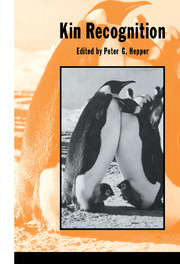Book contents
- Frontmatter
- Contents
- List of contributors
- Preface
- Introduction
- 1 The correlation between kinship and behaviour in non-human primates
- 2 Co-operation and reciprocity in birds and mammals
- 3 Kinship and fellowship in ants and social wasps
- 4 Successes and failures of parent–offspring recognition in animals
- 5 Kinship, kin discrimination and mate choice
- 6 Genetic components of kin recognition in mammals
- 7 Kin recognition in amphibians
- 8 Kin recognition cues of vertebrates
- 9 Recognizing kin: ontogeny and classification
- 10 Parental states as mechanisms for kinship recognition and deception about relatedness
- 11 Fetal learning: implications for the development of kin recognition
- 12 Information processing and storage during filial imprinting
- 13 The honey bee as a model kin recognition system
- 14 Mutual mother–infant recognition in humans
- Author index
- Species and common name index
- Subject index
12 - Information processing and storage during filial imprinting
Published online by Cambridge University Press: 06 January 2010
- Frontmatter
- Contents
- List of contributors
- Preface
- Introduction
- 1 The correlation between kinship and behaviour in non-human primates
- 2 Co-operation and reciprocity in birds and mammals
- 3 Kinship and fellowship in ants and social wasps
- 4 Successes and failures of parent–offspring recognition in animals
- 5 Kinship, kin discrimination and mate choice
- 6 Genetic components of kin recognition in mammals
- 7 Kin recognition in amphibians
- 8 Kin recognition cues of vertebrates
- 9 Recognizing kin: ontogeny and classification
- 10 Parental states as mechanisms for kinship recognition and deception about relatedness
- 11 Fetal learning: implications for the development of kin recognition
- 12 Information processing and storage during filial imprinting
- 13 The honey bee as a model kin recognition system
- 14 Mutual mother–infant recognition in humans
- Author index
- Species and common name index
- Subject index
Summary
In the absence of adult conspecifics, newly-hatched chicks will approach a wide range of bright or moving objects. After a period of exposure to such an object they form a social attachment to it. When they are close to the object the chicks emit soft calls, and if it moves away they will follow it. If subsequently exposed to a new object the chicks will run away emitting distress calls. From these observations it may be inferred that chicks learn about some of the visual characteristics of the first object to which they are exposed. This process is referred to as filial imprinting, and has been studied most intensively in precocial birds such as domestic chicks, ducklings, and goslings (Spalding, 1873; Heinroth, 1911; Lorenz, 1935, 1937; Bateson, 1966). Similar processes may also occur in mammals, but evidence for this is harder to obtain due to their comparative lack of mobility shortly after birth. This chapter will concentrate on the neural and behavioural analysis of filial imprinting in the domestic chick, a species which readily imprints on to a wide range of visual objects.
Imprinting can be reliably reproduced in the laboratory in the following way. Chicks are dark-reared until being exposed to a conspicuous object such as a rotating, illuminated red box, for a period of time, normally several hours. From between two hours to several days later, chicks are given a choice between the object to which they were exposed and a novel object. The extent to which the chick approaches each of the two objects is compared and a preference score calculated.
- Type
- Chapter
- Information
- Kin Recognition , pp. 335 - 357Publisher: Cambridge University PressPrint publication year: 1991
- 3
- Cited by



